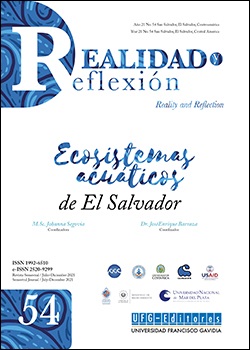Análisis de las estructuras utilizadas para el cultivo de coral: consideraciones para El Salvador
DOI:
https://doi.org/10.5377/ryr.v54i54.12079Palabras clave:
estructuras, restauración, arrecife, El SalvadorResumen
Los arrecifes coralinos son ecosistemas diversos, productivos y complejos, proveen servicios ecosistémicos, pero por acciones naturales y antrópicas está disminuyendo su biodiversidad y salud. Para mitigar la pérdida de cobertura coralina, la restauración es una herramienta de rehabilitación factible que pueden implementarse a corto plazo. Con el objeto de realizar una revisión sistemática de las estructuras utilizadas para cultivo de corales en proyectos de restauración y resaltar la información disponible que proporcionan, se reunieron las descripciones de estos proyectos in situ en las regiones Oceanía, Índico, Atlántico, Caribe, Pacífico Central y Oriental Tropical, identificando los proyectos más destacados. El Caribe presentó mayor número de proyectos (nueve), seguido por el Índico (siete). Los tipos de corales más utilizados para cultivo son ramificados (96 %) y la estructura más utilizada es el árbol de coral. Esta información pretende generar una línea base para considerar el tipo de estructura apta bajo las condiciones de nuestro país.
Descargas
524
Descargas
Publicado
Cómo citar
Número
Sección
Licencia
Derechos de autor 2021 Universidad Francisco Gavidia

Esta obra está bajo una licencia internacional Creative Commons Atribución-NoComercial-CompartirIgual 4.0.
© Universidad Francisco Gavidia (UFG)
Política de acceso abierto y derechos de autor
- El contenido y opiniones vertidas en cada contribución son responsabilidad de sus autores. Los autores ceden los derechos de edición y publicación, en versión impresa y digital, a la Universidad Francisco Gavidia.
- La revista Realidad y Reflexión es alojada en las plataformas institucionales de difusión, así como en bases de datos y otras páginas de divulgación científica.
- Las publicaciones de la Universidad Francisco Gavidia se acogen a la normativa salvadoreña de derechos de autor, contemplada en la Ley de Propiedad Intelectual https://wipolex-res.wipo.int/edocs/lexdocs/laws/es/sv/sv001es.pdf
- UFG Editores no realiza ningún cobro por postular, procesar, publicar o acceder a los aportes publicados; los miembros del Consejo Editorial y quienes conformen el Comité Científico en los número monográficos ejercen sus funciones con carácter Ad honorem.
- La revista Realidad y Reflexión opera bajo la modalidad de acceso abierto, a fin de agilizar la transferencia del conocimiento, disminuir la brecha de acceso a la información, incrementar la visibilidad, y, por lo tanto, la difusión de los aportes publicados.
- La revista declara su compromiso con el acceso abierto en la modalidad diamante, lo que significa que los lectores pueden acceder a todos los contenidos de manera gratuita y sin restricciones, y que los autores no deben asumir ningún costo de publicación o procesamiento de sus documentos.
- Las contribuciones pueden ser descargadas, utilizadas y distribuidas, atendiendo las condiciones de la licencia Creative Commons https://creativecommons.org/licenses/by-nc-sa/4.0/

